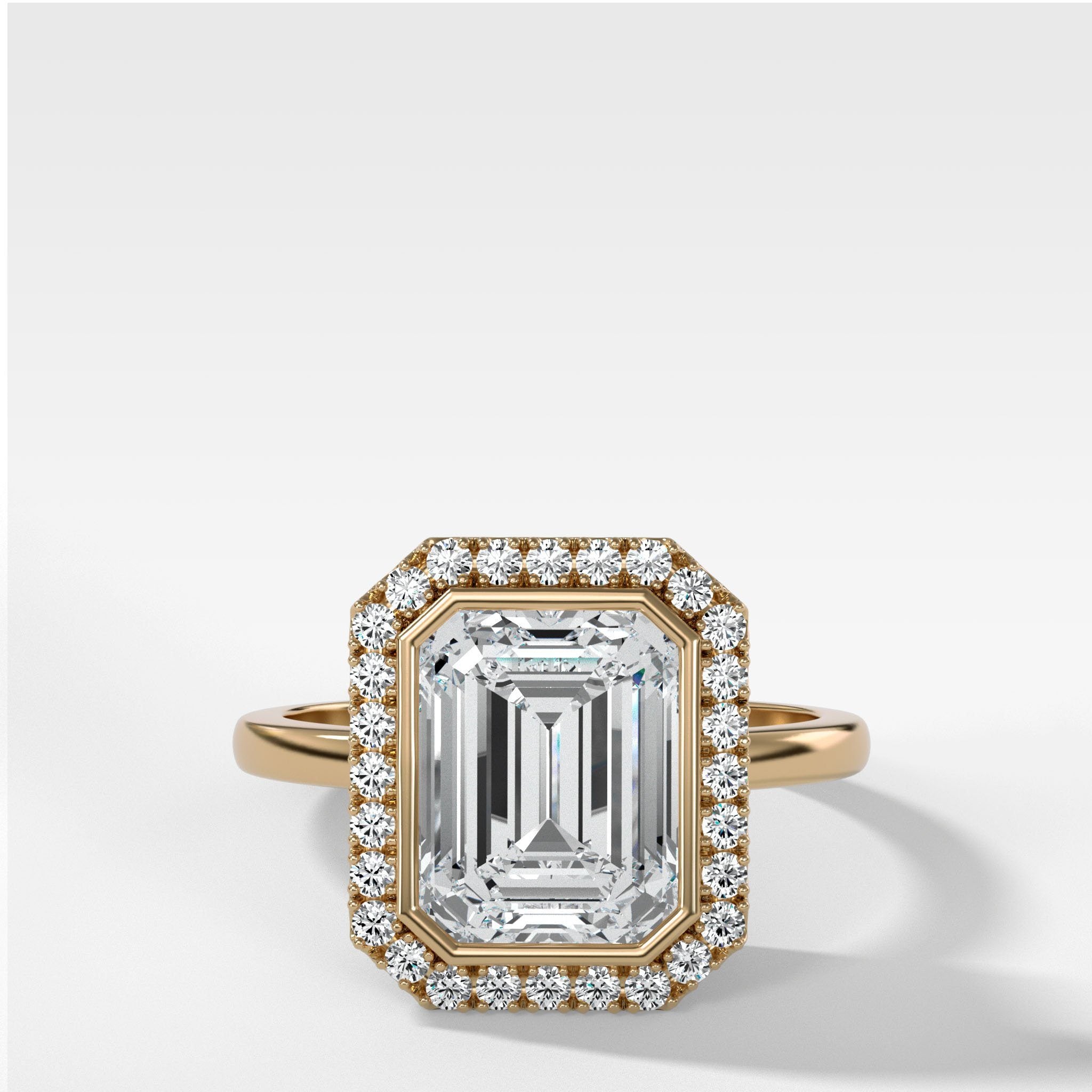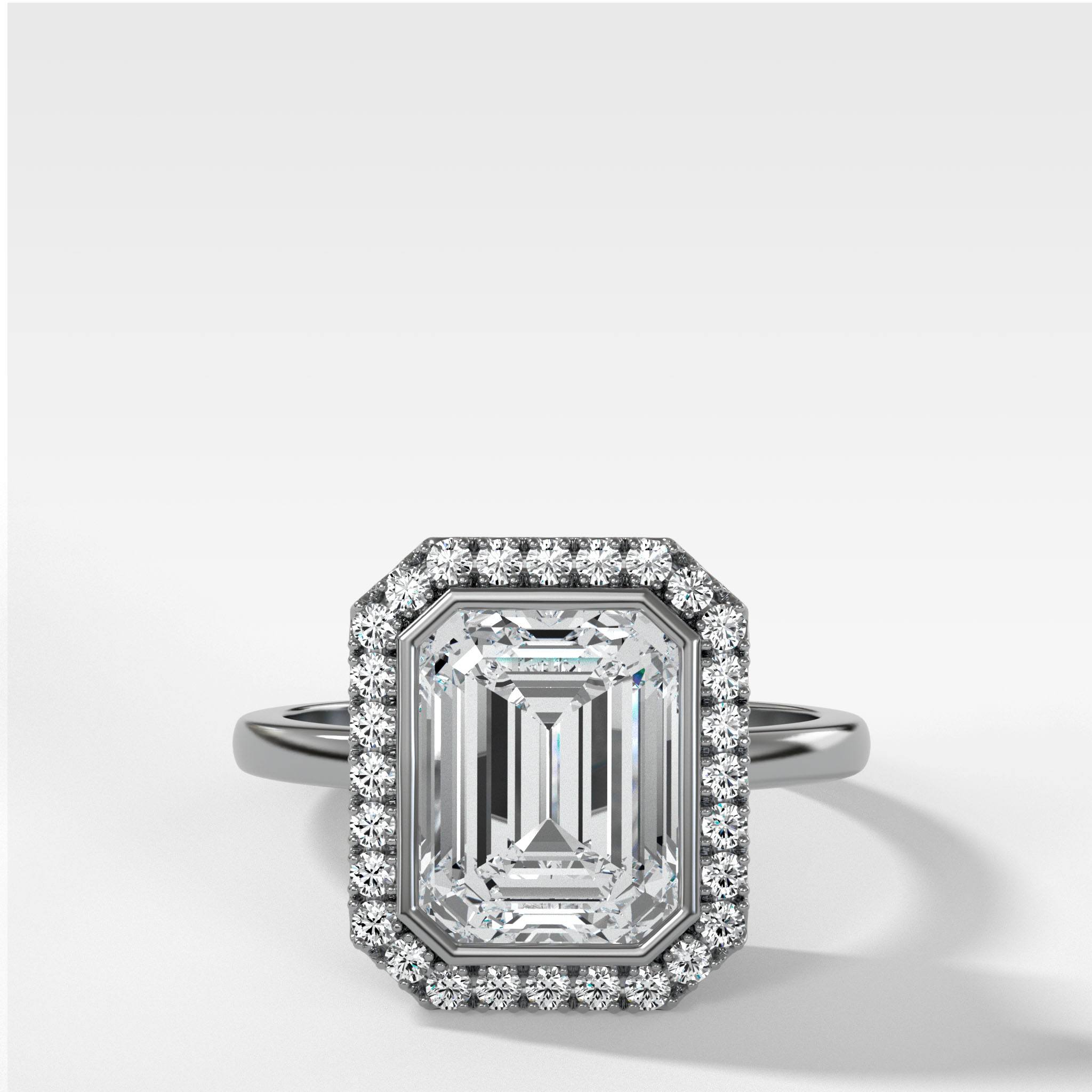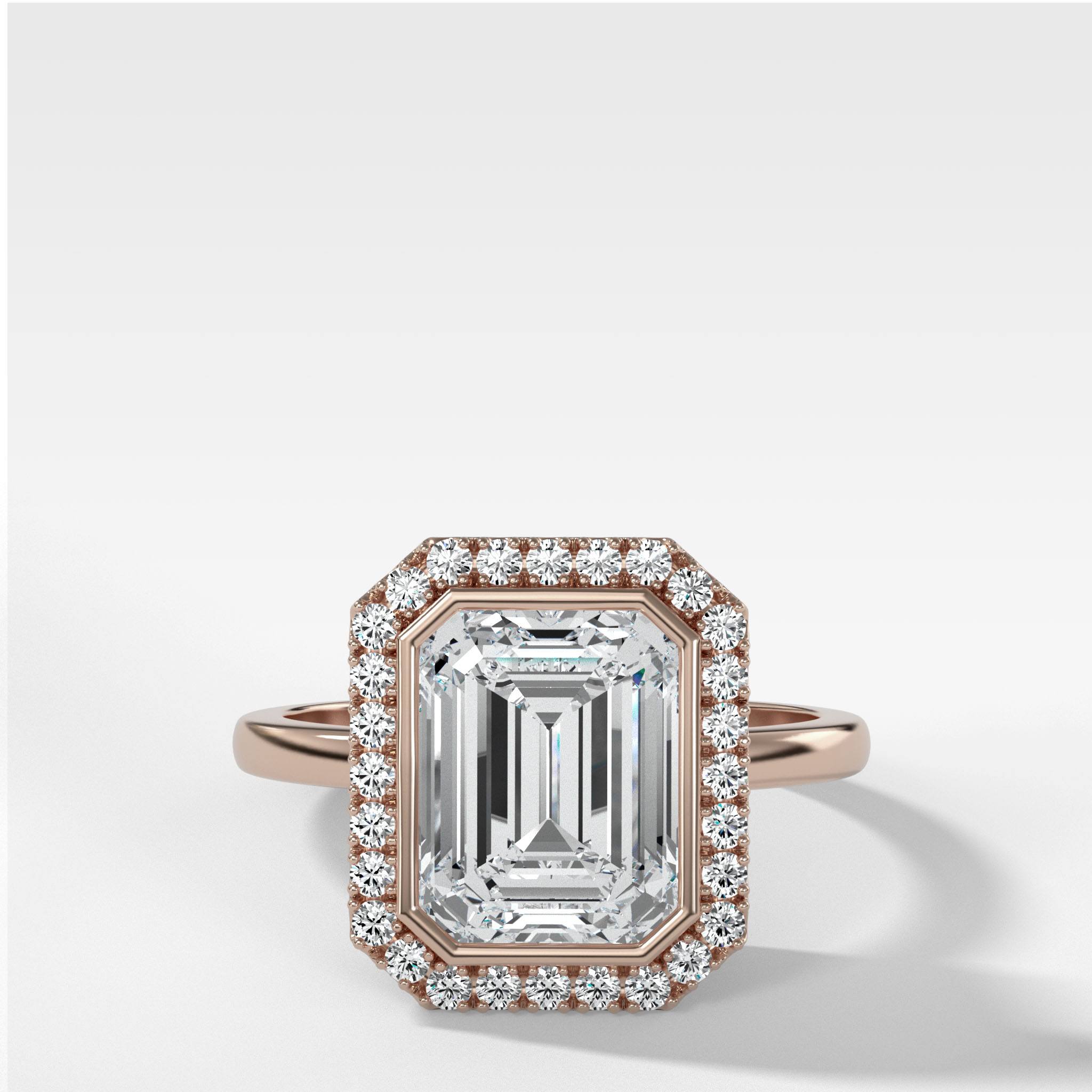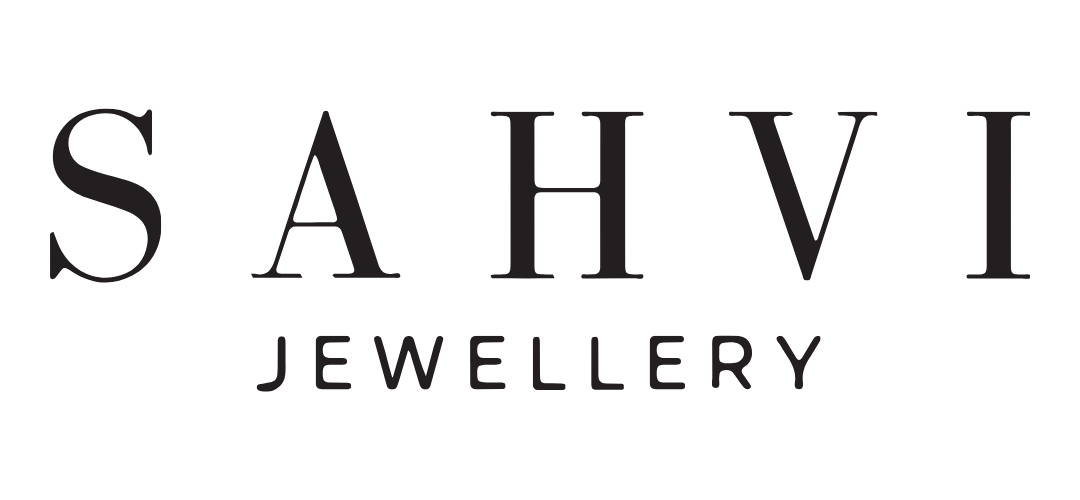



Bezel Set Halo Engagement Ring With Emerald Cut Diamond
To ensure the perfect fit, we'll send you a ring sizing kit after your purchase. Alternatively, you can select your ring size directly below:
Certified Stones, Timeless Guarantee: Moissanites are certified with a lifetime guarantee. Lab-grown Diamonds are certified by IGI. Natural Diamonds are Certified by GIA.
Custom-Made Items
If you are looking for an exquisite diamond ring or desire a custom, one-of-a-kind creation tailored to your unique style, please contact us.
Each custom jewellery piece is meticulously crafted to order and takes approximately 21 business days for production.
Choose options





A Guide to Diamond Quality
When purchasing a diamond, there are four key factors that determine its value: colour, clarity, cut, and carat weight. These are collectively known as the "4Cs."
At Sahvi, we meticulously select each diamond based on its visual appeal and brilliance.
Cut: The cut of a diamond refers to the proportions and angles of its facets. A well-cut diamond maximizes the reflection and refraction of light, resulting in exceptional sparkle. The cut is a crucial factor in determining a diamond's overall beauty.
Colour: Diamonds come in various shades, from colourless (Grade D) to yellow or other fancy colours. Colourless diamonds are generally considered rarer and more valuable.
Carat: A carat is a unit of weight for diamonds, equal to 200 milligrams. While carat weight is often considered a measure of size, it's essential to remember that the overall value of a diamond is determined by the interplay of all four Cs. A well-cut diamond with excellent color and clarity can be more valuable than a larger diamond with inferior characteristics.
Clarity: Clarity refers to the purity of a diamond. Inclusions, or internal flaws, can affect a diamond's appearance and value. Diamonds with fewer inclusions are generally considered to have higher clarity. However, it's important to note that some inclusions may be invisible to the naked eye and may not significantly impact the diamond's overall beauty.
Choosing the right stone
Moissanites are a popular alternative to diamonds, offering a stunning sparkle and durability at a fraction of the cost.
Brilliance: Moissanites are known for their exceptional sparkle and fire, often exceeding that of diamonds due to their higher refractive index.
Hardness: They are incredibly durable, ranking 9.25 on the Mohs scale of hardness, making them resistant to scratches and chipping.
Cost-effective: Moissanites are significantly more affordable than diamonds of comparable size and quality.
Ethical: They are lab-created, eliminating the ethical concerns associated with diamond mining.
Variety: Moissanites are available in various cuts, colors, and sizes, allowing for a wide range of options.
Hypoallergenic: They are generally hypoallergenic, making them suitable for those with sensitive skin.
Lab-grown diamonds are becoming increasingly popular as an alternative to mined diamonds.
Ethical: Lab-grown diamonds are created in a controlled environment, eliminating the ethical concerns associated with diamond mining, such as child labor and environmental damage.
Cost-effective: They are generally more affordable than mined diamonds of comparable size and quality.
Sustainability: The production of lab-grown diamonds has a significantly lower environmental impact than diamond mining.
Quality: Lab-grown diamonds are chemically and physically identical to mined diamonds, offering the same brilliance, hardness, and durability.
Variety: They can be created in a wider range of colours and shapes than mined diamonds.
Customization: Lab-grown diamonds can be customized to specific specifications, such as size, cut, and clarity.
Natural diamonds have been prized for centuries for their beauty, rarity, and durability.
Beauty: Natural diamonds are renowned for their brilliance, fire, and luster. They are often considered the ultimate symbol of love, luxury, and status.
Rarity: Natural diamonds are a rare and precious resource, making them highly valuable and desirable.
Durability: They are incredibly hard, ranking 10 on the Mohs scale of hardness, making them resistant to scratches and chipping.
Resale value: Natural diamonds can hold their value well over time, making them a good investment for some people.
Tradition: Diamonds have a long and rich history, making them a popular choice for engagement rings, wedding bands, and other fine jewelry.

A Guide to Karats and Colors
When it comes to gold jewellery, the karat (kt) value indicates the purity of the gold used.
The higher the karat value, the more gold content the jewellery contains. Here's a breakdown of two common options:
9k Gold (37.5% Gold):
This alloy is a blend of gold with other metals like copper and silver, making it more durable and resistant to scratches.
It has a lighter gold hue and is a more affordable option, perfect for everyday wear.
18k Gold (75% Gold):
With a higher gold content, 18k gold boasts a richer, more vibrant colour. It offers a balance between purity and durability, making it suitable for regular use while maintaining a luxurious feel.
Although slightly softer than 9k gold, it's a popular choice for its premium appearance and value.
Both 9k and 18k gold are available in various colors, including:
Rose Gold: A warm, pinkish hue created by adding copper to the gold alloy.
Yellow Gold: The classic, bright yellow colour associated with gold.
White Gold: A silvery-white colour achieved by adding palladium or nickel to the gold alloy.
Whether you opt for 9k or 18k gold depends on your personal preferences and budget. Consider your lifestyle and how often you'll wear the jewelry when making your decision.
Frequently Asked Questions
The short answer is yes, lab-grown diamonds are real diamonds.
They are chemically, physically, and optically identical to natural diamonds. The only difference lies in their origin.
The Diamond Formation Process
Natural diamonds are formed deep within the Earth's mantle under extreme pressure and temperature. It takes millions of years for these conditions to create a diamond.
Lab-grown diamonds, on the other hand, are created in a laboratory environment using a process called chemical vapor deposition (CVD) or high-pressure, high-temperature (HPHT). This process mimics the conditions found in the Earth's mantle, allowing diamonds to form much more quickly.
The Similarities
- Chemical Composition: Both natural and lab-grown diamonds are composed of pure carbon atoms arranged in a specific crystal structure.
- Physical Properties: They share the same hardness, durability, and thermal conductivity as natural diamonds.
- Optical Properties: Lab-grown diamonds have the same brilliance, fire, and luster as natural diamonds.
The Differences
- Origin: The primary difference between natural and lab-grown diamonds is their origin. Natural diamonds are formed over millions of years in the Earth's mantle, while lab-grown diamonds are created in a laboratory setting.
- Price: Lab-grown diamonds are generally more affordable than natural diamonds of the same size and quality. This is due to the shorter production time and lower manufacturing costs involved in the lab-grown process.
- Ethical Considerations: Some consumers prefer natural diamonds due to their historical and cultural significance. However, lab-grown diamonds offer an ethical alternative, as they do not contribute to the environmental and social issues associated with diamond mining.
Ultimately, whether you choose a natural or lab-grown diamond depends on your personal preferences and priorities. Both types of diamonds are beautiful and durable, and they offer unique benefits to consumers.
Moissanite, a stunning gemstone with a brilliance that rivals diamonds, has a fascinating history that dates back to the late 19th century.
Discovery and Naming:
The story begins in 1893 when French chemist Henri Moissan discovered a new mineral while examining a meteorite. He named this mineral moissanite in honor of himself. However, it was believed to be extremely rare and was not found in significant quantities for many years.
Resurgence in the 21st Century:
The resurgence of moissanite in the jewelry industry began in the late 20th century. Advances in technology allowed for the creation of synthetic moissanite, which is virtually indistinguishable from the natural mineral. This synthetic version offered a more affordable and ethically sourced alternative to diamonds.
Popularity and Benefits:
Moissanite quickly gained popularity among consumers due to its exceptional brilliance, hardness, and durability. Its refractive index is higher than that of diamonds, resulting in a more intense sparkle. Additionally, moissanite is significantly harder than most other gemstones, making it resistant to scratches and wear.
Ethical Considerations:
The popularity of moissanite has also been driven by ethical concerns surrounding the diamond industry. Moissanite is a lab-grown gemstone, eliminating the environmental and social issues associated with diamond mining. This has made it a preferred choice for consumers who value ethical and sustainable jewelry.
Conclusion:
From its discovery as a rare mineral to its widespread use in the jewelry industry, moissanite has come a long way. Its exceptional brilliance, durability, and ethical appeal have made it a popular and sought-after gemstone. As technology continues to advance, it is likely that moissanite will play an even more prominent role in the jewelry industry in the years to come.
To keep your precious ring sparkling:
Soak in soapy water: Immerse your ring in warm, soapy water for a few minutes to loosen dirt and debris.
Rinse thoroughly: Rinse your ring under warm running water to remove all soap residue.
Air dry: Allow your ring to dry naturally on a soft cloth, avoiding direct sunlight or heat sources.
For diamonds or Moissanites:
Gentle brushing: Use a soft-bristled brush to gently remove any remaining dirt or debris from the stones.
Avoid harsh chemicals: Strong chemicals, such as bleach or ammonia, can damage the stones and the gold.

Founders Message
From generations of tradition to a digital future.
At Sahvi, we believe that jewelry is more than just an accessory; it's a reflection of personal brilliance and a timeless expression of style. Our journey began with a deep-rooted heritage in the jewelry trade, dating back to 1929. As the fifth generation in this illustrious lineage, we are proud to carry on the legacy of our family's passion for craftsmanship and exquisite design.
The name "Sahvi" holds a special significance for us. It means "brilliance" in Hebrew, perfectly encapsulating the essence of our brand and the stunning jewelery we offer. Our commitment to quality ensures that every piece you purchase from Sahvi is a testament to both beauty and integrity.
Whether you’re searching for a timeless engagement ring, a stunning wedding band, or a unique statement piece, Sahvi offers personalised designs crafted with exceptional craftsmanship and enduring style. Let us help you create a piece that reflects your unique personality and story.
Where It Started: A Family Legacy
The story of Sahvi begins in the heart of South Africa, where our family's love for jewellery has been passed down through generations. Established in 1929 in Potchefstroom, W.A. Venter Jewelers became a beloved institution in the community, renowned for its exquisite craftsmanship and personalized service.
Anri Human, our co-founder, grew up surrounded by the enchanting world of jewellery. Her father, a forth-generation jeweler, instilled in her a deep appreciation for the artistry and tradition behind each piece. This early exposure ignited Anri's passion for design and her desire to continue the family legacy.
In recent years, Anri's husband, Wynand Human, decided to embrace the family trade and bring the tradition of W.A. Venter Jewelers into the digital age. With a shared vision of creating a contemporary jewelry brand that honors its heritage while embracing modern trends, they founded Sahvi.
Today, Sahvi stands as a testament to the enduring legacy of a family and their unwavering commitment to excellence in jewelry design. Our online store offers a curated collection of stunning pieces, each crafted with the same care and attention to detail that has characterized our family's tradition for nearly a century.
